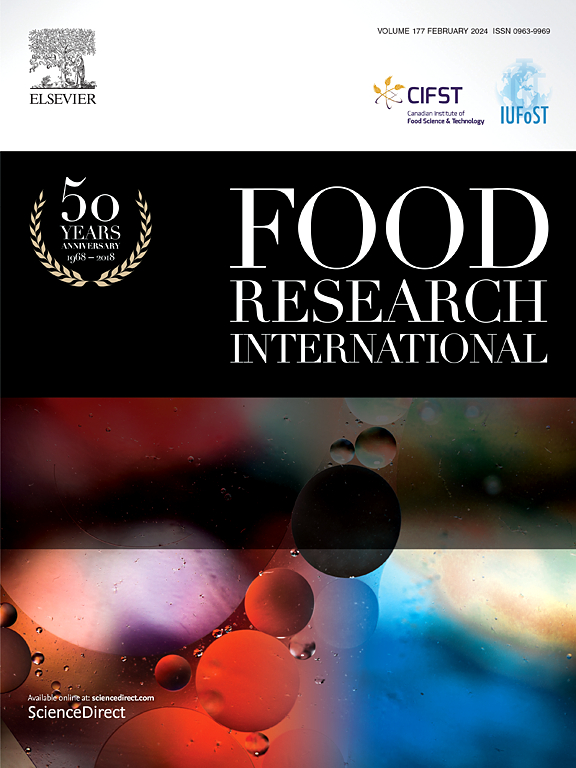Phycocyanin-butterfly pea (Clitoria ternatea L.) anthocyanin nanoparticles as novel high internal phase Pickering emulsion stabilizers with antioxidant and UV shielding properties
IF 7
1区 农林科学
Q1 FOOD SCIENCE & TECHNOLOGY
引用次数: 0
Abstract
Protein-based high internal phase Pickering emulsions (HIPPEs) possess versatile functionalities and extensive applications. However, the structural fragility of native proteins limits their direct use. Herein, butterfly pea anthocyanin (BPACN) was utilized to modify phycocyanin (PC), enhancing its interfacial properties and antioxidant capacity. Covalently crosslinked PC-BPACN nanoparticles (NPs) were synthesized and characterized to explore their interaction mechanisms. The most effective NPs were evaluated for their role as stabilizers in HIPPEs, emphasizing on their emulsifying properties and oxidative stability. The results revealed that PC forms strong interactions with BPACN via covalent bonds, hydrogen bonding, electrostatic interactions, and π-cation interactions. The PC-BPACN-10:1 NPs exhibited a higher negative zeta potential (−39.6 mV), improved surface wettability (81.2°), superior antioxidant capacity, and enhanced thermal stability compared to PC alone. NPs showed a marked increase in β-turns, accompanied by a notable decrease in α-helices, β-sheets, and random coils when compared to PC alone. HIPPEs stabilized by NPs formed a self-supporting gel network that offers excellent storage and oxidative stability, as well as improved retention of astaxanthin under both natural light and UV irradiation. This study highlights the role of BPACN in modifying PC, resulting in enhanced emulsification efficiency and antioxidant capacity, and improved UV shielding performance.

花青素-蝴蝶豌豆(Clitoria ternatea L.)纳米花青素作为具有抗氧化和紫外线屏蔽性能的新型高内相Pickering乳液稳定剂
基于蛋白质的高内相皮克林乳剂(hipes)具有多种功能和广泛的应用。然而,天然蛋白的结构脆弱性限制了它们的直接使用。本研究利用蝴蝶豌豆花青素(BPACN)修饰藻蓝蛋白(PC),提高其界面性能和抗氧化能力。合成了共价交联PC-BPACN纳米颗粒(NPs),并对其进行了表征,探讨了其相互作用机制。评价了最有效的NPs作为hipes稳定剂的作用,强调了它们的乳化性能和氧化稳定性。结果表明,PC与BPACN通过共价键、氢键、静电相互作用和π-阳离子相互作用形成强相互作用。与单独的PC相比,PC- bpacn -10:1 NPs具有更高的负zeta电位(- 39.6 mV),改善的表面润湿性(81.2°),优越的抗氧化能力和增强的热稳定性。与单独的PC相比,NPs的β-匝数明显增加,α-螺旋、β-片和随机线圈明显减少。NPs稳定的hipes形成了一个自我支持的凝胶网络,具有良好的储存和氧化稳定性,并且在自然光和紫外线照射下都能提高虾青素的保留率。本研究强调了BPACN对PC改性的作用,提高了PC的乳化效率和抗氧化能力,改善了PC的紫外线屏蔽性能。
本文章由计算机程序翻译,如有差异,请以英文原文为准。
求助全文
约1分钟内获得全文
求助全文
来源期刊

Food Research International
工程技术-食品科技
CiteScore
12.50
自引率
7.40%
发文量
1183
审稿时长
79 days
期刊介绍:
Food Research International serves as a rapid dissemination platform for significant and impactful research in food science, technology, engineering, and nutrition. The journal focuses on publishing novel, high-quality, and high-impact review papers, original research papers, and letters to the editors across various disciplines in the science and technology of food. Additionally, it follows a policy of publishing special issues on topical and emergent subjects in food research or related areas. Selected, peer-reviewed papers from scientific meetings, workshops, and conferences on the science, technology, and engineering of foods are also featured in special issues.
 求助内容:
求助内容: 应助结果提醒方式:
应助结果提醒方式:


